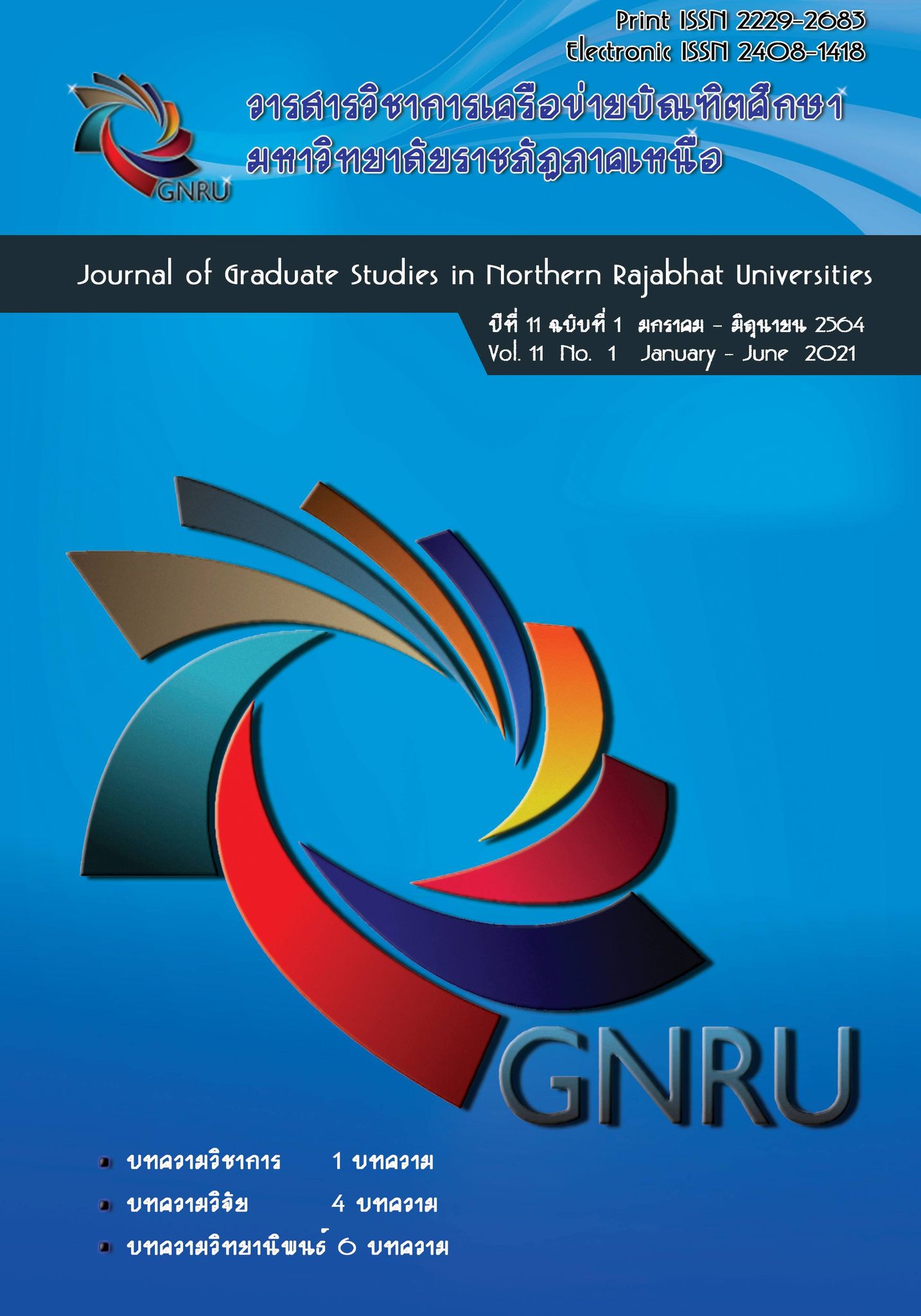การอนุรักษ์และสร้างจิตสำนึกต่อภูมิปัญญาท้องถิ่นไทลื้อลวงเหนือผ่านการบูรณาการการจัดการเรียนรู้แบบมีส่วนร่วมโดยใช้โรงเรียนเป็นฐาน Conservation of and Raising Awareness on Tai Lue Local Wisdom at Luang Nua through the Integration of a School-Based Participatory Learning Management
Main Article Content
Abstract
การวิจัยในครั้งนี้ มีวัตถุประสงค์เพื่อ 1)ศึกษาการบูรณาการการจัดการเรียนรู้แบบมีส่วนร่วมโดยใช้โรงเรียนเป็นฐานเพื่อสร้างจิตสำนึกในการอนุรักษ์ภูมิปัญญาท้องถิ่นไทลื้อลวงเหนือ และ2)ศึกษาผลการสร้างจิตสำนึกในการอนุรักษ์ภูมิปัญญาท้องถิ่นไทลื้อของนักเรียนโรงเรียนบ้านลวงเหนือ กลุ่มเป้าหมายคือนักเรียนชั้นประถมศึกษาปีที่ 1-6 โรงเรียนบ้านลวงเหนือ จำนวน 96 คน เครื่องมือที่ใช้ในการเก็บรวบรวมข้อมูลได้แก่แบบวิเคราะห์เอกสาร แบบสัมภาษณ์ชุมชน แนวทางการระดมสมอง แบบประเมินคุณภาพของคู่มือ ภูมิปัญญาท้องถิ่นไทลื้อ แบบสังเกตพฤติกรรมการมีส่วนร่วมของผู้มีส่วนเกี่ยวข้อง แบบสังเกตพฤติกรรม การสอนของครู แบบประเมินจิตสำนึกในอนุรักษ์ภูมิปัญญาท้องถิ่นไทลื้อลวงเหนือ แบบสัมภาษณ์ความคิดเห็นของผู้มีส่วนเกี่ยวข้อง หาคุณภาพของเครื่องมือใช้วิธีการหาค่าดัชนีความสอดคล้องระหว่างเนื้อหากับจุดประสงค์(Index of Item – Objective Congruence หรือ IOC)จากผู้เชี่ยวชาญ ค่าอยู่ระหว่าง 0.60 – 1.00 ทุกฉบับ วิเคราะห์ข้อมูลเชิงปริมาณโดยใช้ค่าเฉลี่ย ร้อยละ และข้อมูลเชิงคุณภาพใช้การวิเคราะห์เชิงเนื้อหา
ผลการวิจัยสรุปได้ดังนี้ 1. การบูรณาการการจัดการเรียนรู้แบบมีส่วนร่วมโดยใช้โรงเรียนเป็นฐานเพื่อสร้างจิตสำนึกใน การอนุรักษ์ภูมิปัญญาท้องถิ่นไทลื้อลวงเหนือ ใช้กระบวนการวิจัยเชิงปฏิบัติการแบบมีส่วนร่วม 7 ขั้นตอน คือ 1)ขั้นการเตรียมการ 2)ขั้นการวางแผน 3)ขั้นการปฏิบัติ 4)ขั้นการสะท้อนผล 5)ขั้นการปฏิบัติ 6)ขั้นการสังเกต และ7)ขั้นการสะท้อนผล 2. ผลการสร้างจิตสำนึกในการอนุรักษ์ภูมิปัญญาท้องถิ่นไทลื้อของนักเรียนโรงเรียนบ้านลวงเหนือ 2.1) ผลการเปรียบเทียบคะแนนจิตสำนึกในการอนุรักษ์ภูมิปัญญาท้องถิ่นของนักเรียน พบว่า ค่าเฉลี่ยร้อยละของคะแนนจิตสำนึกในการอนุรักษ์ภูมิปัญญาท้องถิ่นผ่านเกณฑ์ร้อยละ 75 ทุกระดับชั้น 2.2) ความคิดเห็นของผู้มีส่วนร่วมพบว่า ครูมีความรู้สึกที่ดีต่อการจัดกิจกรรมการเรียนรู้ ชุมชนมีความรู้สึกดีใจที่ได้เข้ามามีส่วนร่วมในการจัดกิจกรรมการเรียนรู้จนเกิดศูนย์อัตลักษณ์ไทลื้อขึ้นในโรงเรียน นักเรียนมีความสุข สนุกสนาน เกิดความภาคภูมิใจในศิลปะ วัฒนธรรม ประเพณี และวิถีชีวิตของไทลื้อ
The objectives of this research were to investigate the integration of a school-based participatory learning management to raise awareness on the conservation of Tai Lue wisdom at Luang Nua, and to study the results of awareness-raising on Tai Lue wisdom conservation among students at Ban Luang Nua School. The target group consisted of 96 Prathom 1-6 students at the school. The data collection instruments included a documentary analysis, a community interview, a brainstorming guideline, a quality assessment of the Tai Lue wisdom handbook, a participatory behavioral observation record of concerned individuals, a teachers’ instructional behavioral observation record, an assessment on awareness on the Tai Lue wisdom conservation, and an interview for concerned individuals. The Index of Item-Objective Congruence (IOC) was applied to find out the quality of the instruments by experts, and their values ranged from 0.60 to 1.00. The quantitative data were statistically analyzed for mean and percentage, and the content analysis was used to analyze the qualitative data.
The research results are summarized as follows. 1. The integration of the school-based participatory learning management utilized seven steps of the participatory action research process. The steps included preparation, planning, action 1, reflection 1, action 2, observation, and reflection 2. The results of raising awareness on Tai Lue wisdom conservation of the students were as follows. 2.1) The comparison of their awareness scores revealed that the average percentage points of their awareness scores passed the 75-percent criterion in all levels. 2.2) The opinions of concerned individuals revealed that the teachers had positive opinions on the organization of the learning activities. The community members were pleased to participate in organizing learning activities until a Tai Lue identity center was established in the school. The students were happy, enjoyed themselves and took pride in their ethnic arts, culture, traditions, and lifestyles.
Article Details
References
คนึง เทวฤทธิ์, วิมลรัตน์ สุนทรโรจน์, และอภิราดี จันทร์แสง. (2559, ธันวาคม). การพัฒนารูปแบบการจัดการเรียนรู้เพื่อส่งเสริมจิตสำนึกรักท้องถิ่นของนักเรียนชั้นมัธยมศึกษาตอนปลายโดยใช้กระบวนการทางสังคม. วารสารการวัดผลการศึกษา มหาวิทยาลัยมหาสารคาม. 22(2), 42-51.
ชูชาติ พ่วงสมจิตร์. (2557). การวิจัยปฏิบัติการแบบมีส่วนร่วม. เอกสารการสอน ชุดวิชา 23721 การวิจัยการบริหารการศึกษา หน่วยที่ 6 มหาวิทยาลัยสุโขทัยธรรมาธิราช. (พิมพ์ครั้งที่ 2). นนทบุรี: สำนักพิมพ์มหาวิทยาลัยสุโขทัยธรรมาธิราช.
ณัฐฐ์วัฒน์ สุทธิโยธิน. (2559). ทฤษฎีเกี่ยวกับจิตสำนึก การสร้างจิตสำนึกและการปลูกฝังจิตสำนึก. สืบค้นเมื่อ 17 มีนาคม 2563 , จากhttp://nattawatt.blogspot.com/2016/12/consciousness.html
ไพศาล วรคำ. (2552). การวิจัยทางการศึกษา. กาฬสินธุ์: ประสานการพิมพ์.
ยุพิน อินทะยะ. (2560). แหล่งการเรียนรู้และภูมิปัญญาท้องถิ่นเพื่อการเรียนการสอน. เชียงใหม่: คณะครุศาสตร์ มหาวิทยาลัยราชภัฏเชียงใหม่.
สำเนา หมื่นแจ่ม. (2558). รายงานการวิจัยการพัฒนาครูในการสร้างฐานข้อมูลแหล่งเรียนรู้และภูมิปัญญาท้องถิ่นเพื่อยกระดับคุณภาพการเรียนการสอน. เชียงใหม่: คณะครุศาสตร์ มหาวิทยาลัยราชภัฏเชียงใหม่.
อมาวสี อัมพันศิริรัตน์, และพิมพิมล วงศ์ไชยา. (2560, ธันวาคม). การวิจัยเชิงปฏิบัติการแบบมีส่วนร่วม: ลักษณะสำคัญและการประยุกต์ใช้ในชุมชน. วารสารมนุษยศาสตร์และสังคมศาสตร์ มหาวิทยาลัยมหาสารคาม. 36(6), 192-202.
Attwood, H. (1997). An overview of issues around the use of participatory approaches by postgraduate students. In IDS, Participatory Research, IDS PRATopic Pack (February,1997). Brighton: IDS, University of Sussex.
Farthing, G. W. (1992). The psychology of consciousness. New Jersey : Prentice Hall.
Stringer,ET. (2007). Action Research. (3rd ed.) Los Angeles: Sage.


